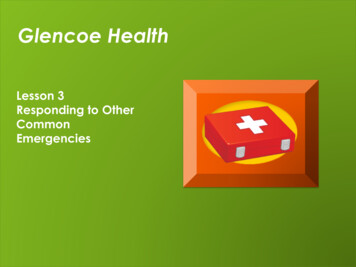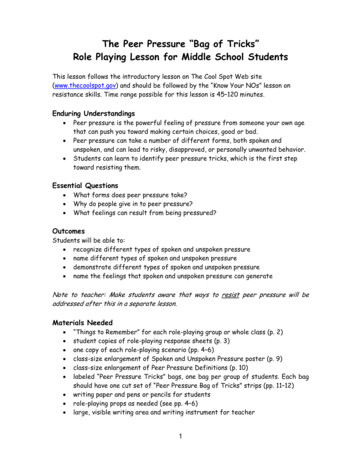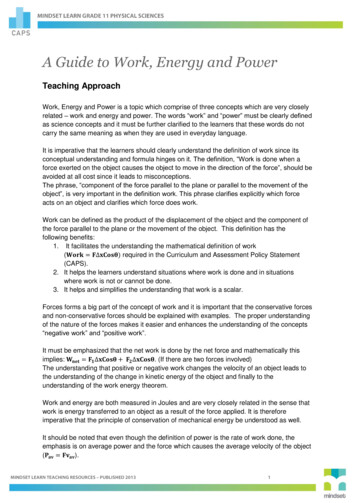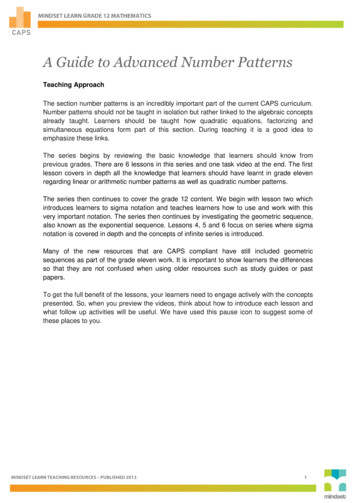
Transcription
Glencoe HealthLesson 3Responding to OtherCommonEmergencies
LESSON 3Responding to Other Common EmergenciesBIGIDEAYou can use first aid to deal with commonemergencies such as muscle and boneinjuries, impaired consciousness, animalsbites, nosebleeds, and poisoning.New Vocabularyfracturepoisondislocationpoison control centerunconsciousnessvenomconcussionGlencoe Health Chapter 27 First Aid and EmergenciesLesson Home
LESSON 3Responding to Other Common EmergenciesMuscle, Joint, and Bone InjuriesMain IdeaMuscle and joint injuries can be minor or severe,but bone injuries are always medicalemergencies.You should know the proper first-aid proceduresfor treating injuries such as strains, sprains,fractures, and dislocations in case accidentshappen.Glencoe Health Chapter 27 First Aid and EmergenciesLesson Home
LESSON 3Responding to Other Common EmergenciesMuscle and Joint InjuriesTwo common and fairly minor injuries are strainsand sprains.StrainA tear in a muscleSprainAn injury to the ligamentsaround a jointGlencoe Health Chapter 27 First Aid and EmergenciesLesson Home
LESSON 3Responding to Other Common EmergenciesMuscle and Joint InjuriesStrains and sprains vary in severity.Severe strains and sprains will require medicalcare.Glencoe Health Chapter 27 First Aid and EmergenciesLesson Home
LESSON 3Responding to Other Common EmergenciesMuscle and Joint InjuriesCall 9-1-1 for emergency medical help if:the person is unable to move the affected muscle orjoint.the pain is severe.the injury is bleeding.the joint appears deformed.you hear a popping sound coming from the joint.Glencoe Health Chapter 27 First Aid and EmergenciesLesson Home
LESSON 3Responding to Other Common EmergenciesMuscle and Joint InjuriesTreat minor strains and sprains with the P.R.I.C.E.procedure.You can gradually begin to use the affectedbody part again as the pain and swellingsubside. If the swelling lasts more than two days,see a doctor.Glencoe Health Chapter 27 First Aid and EmergenciesLesson Home
LESSON 3Responding to Other Common EmergenciesMuscle and Joint InjuriesThe P.R.I.C.E. ProcedureProtect the affected area by wrapping it in abandage or splint.Rest the injured body part for at least a day.Ice the affected area for 10 to 15 minutes at a time,three times a day to reduce swelling and pain.Compress the affected area by wrapping it firmly, butnot too tightly, in a bandage.Elevate the injured body part above the level of theheart, if possible.Glencoe Health Chapter 27 First Aid and EmergenciesLesson Home
LESSON 3Responding to Other Common EmergenciesFractures and DislocationsInjuries to bones include fractures anddislocations.New VocabularyfractureA break in the bone.Glencoe Health Chapter 27 First Aid and EmergenciesLesson Home
LESSON 3Responding to Other Common EmergenciesFractures and DislocationsFractures and dislocations are emergencies thatrequire immediate medical attention.New VocabularydislocationA separation of a bone from its normalposition in a joint.Glencoe Health Chapter 27 First Aid and EmergenciesLesson Home
LESSON 3Responding to Other Common EmergenciesFractures and DislocationsThe first-aid procedures for fractures anddislocations are the same.1Call 9-1-1 or your local emergency medicalservice.2Do your best to keep the victim still and calm.3If the skin is broken, rinse the area carefully toprevent infection, taking care not to disturb thebone.Glencoe Health Chapter 27 First Aid and EmergenciesLesson Home
LESSON 3Responding to Other Common EmergenciesFractures and DislocationsThe first-aid procedures for fractures anddislocations are the same.4If necessary, apply a splint to immobilize theinjured body part to prevent further injury.5Apply an ice pack to reduce pain and swelling.6If the injury does not affect the head, neck, legs, orspine, ask the victim to lie down. Use a chair orpillow to raise his or her legs about 12 inches toprevent shock.Glencoe Health Chapter 27 First Aid and EmergenciesLesson Home
LESSON 3Responding to Other Common EmergenciesUnconsciousnessMain IdeaA victim who loses consciousness for anyamount of time requires medical care.Although most drowning incidents involve youngchildren, people of all age groups need to payattention to water safety guidelines.Glencoe Health Chapter 27 First Aid and EmergenciesLesson Home
LESSON 3Responding to Other Common EmergenciesUnconsciousnessWhen a person is in a state of unconsciousness,he or she is not able to respond to simplecommands.New VocabularyunconsciousnessThe condition of not being alert or awareof your surroundings.Glencoe Health Chapter 27 First Aid and EmergenciesLesson Home
LESSON 3Responding to Other Common EmergenciesUnconsciousnessFollow these steps if you encounter someonewho has lost consciousness.Call 9-1-1Glencoe Health Chapter 27 First Aid and EmergenciesCheck theperson’sbreathingBe preparedto performCPRLesson Home
LESSON 3Responding to Other Common EmergenciesUnconsciousnessIf the person is breathing and does not seem tohave an injury to the spine, lay the person downin the recovery position.The person should be laying on his or her side,with one arm supporting the head, and themouth tilted toward the floor.Glencoe Health Chapter 27 First Aid and EmergenciesLesson Home
LESSON 3Responding to Other Common EmergenciesFaintingFainting is a temporary loss of consciousness thatoccurs when not enough blood is flowing to thebrain.A person who has fainted should see a doctor assoon as possible if he or she has never faintedbefore, or if fainting occurs frequently.Glencoe Health Chapter 27 First Aid and EmergenciesLesson Home
LESSON 3Responding to Other Common EmergenciesConcussionA person who loses consciousness orexperiences memory loss or confusion becauseof a head injury might have a concussion.New VocabularyconcussionA jarring injury to the brain that cancause unconsciousness.Glencoe Health Chapter 27 First Aid and EmergenciesLesson Home
LESSON 3Responding to Other Common EmergenciesConcussionCall 9-1-1 for all cases of suspected concussion.If the person is conscious, have him or her liedown.Use first-aid to treat any bleeding while you waitfor help to arrive.Glencoe Health Chapter 27 First Aid and EmergenciesLesson Home
LESSON 3Responding to Other Common EmergenciesConcussionIf the person is unconscious, avoid moving him orher if you suspect that he or she may have ahead or neck injury.If you do not suspect a head or neck injury,move the person into the recovery position.Glencoe Health Chapter 27 First Aid and EmergenciesLesson Home
LESSON 3Responding to Other Common EmergenciesOther EmergenciesMain IdeaIt is important to learn first-aid procedures foremergencies, such as animal bites, nosebleeds,and poisoning.Learning proper first-aid procedures will help youstay calm and respond appropriately in theevent of an emergency.Glencoe Health Chapter 27 First Aid and EmergenciesLesson Home
LESSON 3Responding to Other Common EmergenciesAnimal BitesAnimal bites can transmit serious diseases suchas rabies, a viral infection that can be incurableand deadly if not treated immediately.A tetanus booster shot may be required for anybite that has broken the skin.Glencoe Health Chapter 27 First Aid and EmergenciesLesson Home
LESSON 3Responding to Other Common EmergenciesAnimal Bites Wash your hands thoroughly and put onprotective gloves. Wash the bite area thoroughly with mild soap andwater. Apply pressure as needed to stop any bleeding. Apply antibiotic ointment and a sterile dressing If the wound swells, apply ice wrapped in a towelfor ten minutes.Glencoe Health Chapter 27 First Aid and EmergenciesLesson Home
LESSON 3Responding to Other Common EmergenciesNosebleeds Sit down and squeeze the soft part of the nosebetween your thumb and finger, holding thenostrils closed. Breathe through your mouth and lean forward toavoid swallowing blood. An ice pack or cold compress applied to thebridge of the nose may also help. If the bleeding does not stop after 20 minutes,seek emergency medical help.Glencoe Health Chapter 27 First Aid and EmergenciesLesson Home
LESSON 3Responding to Other Common EmergenciesPoisoningA poison can be a solid, liquid, or gas.New VocabularypoisonAny substance that causes injury, illness,or death when it enters the body.Glencoe Health Chapter 27 First Aid and EmergenciesLesson Home
LESSON 3Responding to Other Common EmergenciesPoisoningThe first step in any case of suspected poisoningis to call a poison control center.New Vocabularypoison control centerA round-the-clock service that providesemergency medical advice on how totreat victims of poisoning.Glencoe Health Chapter 27 First Aid and EmergenciesLesson Home
LESSON 3Responding to Other Common EmergenciesPoisoningThe poison control expert will ask you questionsand provide you with step-by-step instructions onhow to threat the person who is poisoned.Do not give the person any medication unlessthe expert with the poison control center tellsyou to do so.Glencoe Health Chapter 27 First Aid and EmergenciesLesson Home
LESSON 3Responding to Other Common EmergenciesSnakebiteCertain types of snakes can inject venom into aperson’s body.New VocabularyvenomA poisonous secretion.Glencoe Health Chapter 27 First Aid and EmergenciesLesson Home
LESSON 3Responding to Other Common EmergenciesSnakebite Call 9-1-1 for medical help and follow thedispatcher’s instructions. Try to keep the person from moving. Keep the affected body part below chest level. Remove rings and other constricting items. Use a snakebite suction kit if one is available.Glencoe Health Chapter 27 First Aid and EmergenciesLesson Home
LESSON 3Responding to Other Common EmergenciesInsect and Spider Bites or StingsThe stings of insects such as bees, hornets, andwasps, as well as the bites of certain spiders, arepainful but usually not dangerous.A person who is allergic to these insects andspiders may have a severe reaction. If someoneallergic to the venom has been stung or bitten,call 9-1-1.Glencoe Health Chapter 27 First Aid and EmergenciesLesson Home
LESSON 3Responding to Other Common EmergenciesInsect and Spider Bites or Stings Remove the stinger by scraping it off with a firm,straight-edged object. Do not use tweezers, since they may cause thestinger to release more venom. Wash the site thoroughly with mild soap andwater to help prevent infection. Apply ice (wrapped in a cloth) to the site,alternating ten minutes on, then ten minutes off,to reduce pain and swelling.Glencoe Health Chapter 27 First Aid and EmergenciesLesson Home
LESSON 3Responding to Other Common EmergenciesPoisonous PlantsMost people are allergic to poison ivy, poisonoak, and poison sumac.Exposure to these plants will cause itching,swelling, redness, burning, and blisters at the siteof contact.Glencoe Health Chapter 27 First Aid and EmergenciesLesson Home
LESSON 3Responding to Other Common EmergenciesPoisonous Plants If you brush up against a poisonous plant, do notrub your skin. Washing the area immediately with soap andwater may prevent a reaction. Wash any clothing or other objects that havetouched the plant as well. An over-the-counter cream or oral antihistaminemay ease the itching.Glencoe Health Chapter 27 First Aid and EmergenciesLesson Home
LESSON 3Responding to Other Common EmergenciesPoisonous PlantsExposure to poison ivy, poison oak, and poisonsumac can cause itching, swelling, and blisters.Glencoe Health Chapter 27 First Aid and EmergenciesLesson Home
LESSON 3 ReviewResponding to Other Common EmergenciesAfter You ReadReviewing Facts and Vocabulary1. What are the symptoms of a fracture ordislocation?Severe pain, swelling, bruising, and inability tomove the affected body part.Glencoe Health Chapter 27 First Aid and EmergenciesLesson Home
LESSON 3 ReviewResponding to Other Common EmergenciesAfter You ReadReviewing Facts and Vocabulary2. Why is the recovery position the safestposition for an unconscious person?It protects the airway from becomingcongested.Glencoe Health Chapter 27 First Aid and EmergenciesLesson Home
LESSON 3 ReviewResponding to Other Common EmergenciesAfter You ReadReviewing Facts and Vocabulary3. What is the first step in any case ofsuspected poisoning?Call a poison control center.Glencoe Health Chapter 27 First Aid and EmergenciesLesson Home
Glencoe HealthEnd ofChapter 27First Aid andEmergenciesLesson 3Responding to OtherCommonEmergenciesLesson Home
You can use first aid to deal with common emergencies such as muscle and bone injuries, impaired consciousness, animals bites, nosebleeds, and poisoning. poison unconsciousness concussion poison control center venom LESSON 3 Responding to Other Common Emergencies Glencoe Health Chapter 27 First










